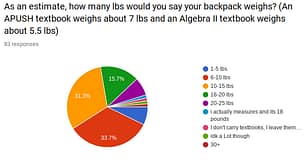[dropcap]B[/dropcap]ack to school shopping is something many students both love and hate. It signifies the end of summer and beginning of school, but students also get to buy fancy pens and markers that will almost certainly not be used for educational means.
From pencils to notebooks to highlighters, there are many things students need for school, however the most important item is often overlooked. Textbooks are often overlooked as school supplies because the school provides them for middle and high school students. However they are incredibly important because without them, students wouldn’t have anything to learn from. Every year, schools in the U.S. buy 7 to 9 billion dollars worth of textbooks. However, are paper textbooks really the best way to go? Here are some of the top reasons why schools should switch to online textbooks.
[perfectpullquote align=”right” bordertop=”false” cite=”” link=”” color=”” class=”” size=””]Are paper textbooks really the best way to go?[/perfectpullquote]
Integrating Technology Into The Students’ Lives
After all isn’t technology the future? As the world becomes more fixated around technology, the people who are coming into the world (the students) also need to learn how to use it. While the students do learn how to use technology on their own, they often don’t learn how to use the more school or business oriented functions on their own. If schools would get technology like iPad, Chromebooks, or computers for students and transfer all the textbooks online, the students most definitely have the chance to use their technology for other uses besides simply using them to read their textbooks. They will also learn how to type, a skill that is vital for life, as well as how to create presentations, which is extremely important for many careers.
By introducing technology into students’ lives early, they will struggle less when it counts, and will be able to learn the basics of how to use technology so they can build upon that basis if necessary later in life.
Introducing technology into schools gives students opportunities to learn skills they might not otherwise learn until they are adults.
Better Learning and Communication
Technology can help students learn the information more effectively. Studies have proved that technology based instruction can reduce the amount of time it takes a student to understand an objective by 30% to 80%. If schools provide all students with an opportunity to learn from technology through online textbooks, it will help students learn more information in less time.
Also, when schools get out, many people still have questions or need help with the homework. Those students don’t always have the time to go see a teacher after school and sometimes they don’t even realise that they need that help. With the access to technology, whether it be chromebooks, computers, or iPads, kids can email their teachers about the things they don’t understand or look up how to do it online. In addition, students can also work together easier on group projects. The access to technology also make sure that students can type up essays and papers in case they don’t have access to a computer at home.
In addition, online textbooks allow students to highlight information and take notes right in the book, whereas in a paper textbook, students can’t mark the textbooks up because the school owns the textbooks, not the students.
Online textbooks can better help the students understand and process the information they are being taught.
Objection! Your Honor, What About The Cost?
What about the cost indeed. If your objections are surrounding the cost of buying tablets or computers for everyone on top of buying the online versions of textbooks, you’re not the only one. One of the most common complaints is how much it would cost the school and the students.
Because I’m most familiar with Chromebooks, that is what I’m going to be using for this example, as well as it being a good middle ground as far as texhnology goes (you can’t type on iPads or other tablets and normal computers are both too expensive and have more functions than an average student needs). It costs about $300-$500 to get a chromebook and then an additional $20-30 cost for the textbook, however paper textbooks often cost at least $100 if not more. While schools don’t have to replace the textbooks every year, they do have to at least every ten years to make sure the textbooks are in good shape and not outdated. They tend to replace textbooks every 6 years or so. And since students usually need 2-4 textbooks every year, to buy enough textbooks for every student in all the subjects they need it for (usually math, science, and social studies), even though schools only replace it every 6 or so years, assuming there are about 200 students per grade, three textbooks per student, $100 per textbook, it would cost about $60,000 to get one grade’s textbooks. This means if you have a 7-12 school, every year the school has to replace one grade’s textbooks.

Image by Startup Stock Photos
In contrast, if you get a good chromebook it can last one student most of their middle and high school career. A chromebook automatically stops updating five years after its’ release date, however it can keep functioning beyond that date. So if schools were to give students Chromebooks in the beginning of high school or towards the end of middle school, they would not reach its’ end of life until either after they graduated. In addition, since Chromebooks last past its’ “end of life” it would be possible to make them last six or seven years, giving them to students in sixth or seventh grade. So if a school has 200 students, with a Chromebook costing $400, and 3 textbooks at $25 per student, it would cost about $95,000 for one grade to get Chromebooks with textbooks. That means every year, the school would have to pay around $35,000 more for Chromebooks vs textbooks.
However, it is possible for schools to get funding for this additional money. There are many grants that schools can apply to for grants that are specifically geared towards technology. Even without these grants, to pay for the additional $35,000, it would only cost $175 per student to make up the money. The benefits from getting the technology far outweighs the cost.
Heavy Textbooks Are Hurting Our Backs
One of the top reasons that online textbooks would be better than traditional paper textbooks is because of the weight of students’ backpacks when carrying around paper textbooks. To understand why the heavy textbooks affect students’ health, we first have to look at how heavy backpacks affect kids’ backs.
It was found that a backpack that is more than 10% of a student’s body weight can cause a shallowing of the lumbar lordosis and a tendency towards a vertical position of the sacrum.
Why is that bad? Well according to that same paper, at a minimum, it can lead to bad posture which can cause headaches, fatigue, and cervical and lumbar pain. Worst case, excessive back load can lead to pain and spinal deformities. This is because the majority of the exposure to excessive back load happens when students’ bodies are still developing and growing.
So 10% max? How hard is that? Well according to the CDC, the average weight for a 12 year old boy, the age most sixth graders are, is 89.7 lbs (40.7 kg). The average weight for 12 year old girl is 92.2 lbs (41.8 kg). So the average sixth grader shouldn’t have a backpack that exceeds 9 lbs (4 kg). However, when students graduate in twelfth grade, the average 18 year old boy weighs 148.4 lbs (67.3 kg) and the average 18 year old girl weighs 123.9 lbs (56.2 kg). This means that when they are graduating, students’ backpacks shouldn’t be more than 12.4-14.8 lbs (5.6-6.7 kg). This means that with a 50-50 ratio of girls and boys, the average backpack should weigh 13.6 lbs (6.2 kg).
To give perspective, I took a survey of 83 high school students, the majority of who were in 10th grade (98.8%) They also gave me an estimate of how much their backpacks weigh. 33.7% said 6-10 lbs (2.7-4.5 kg), 31.3% said 10-15 lbs, (4.5-6.8 kg), 16.9% said 16-20 lbs (6.8-9.1 kg), 7.2% said 20-25 lbs (9.1-11.3 kg), 7.2% said 1-5 lbs (0.5-2.3 kg), 1.2% said 30+ lbs (13.6+ kg), and 2.4% giving inconclusive results. This means that around 40.9% of students have backpacks that weigh more than the average backpack should, the average backpack being 12 lbs (5.4 kg).
Although the average weight of these results is under the average of what the maximum weight of a backpack should be, it must be taken into perspective that my school already has provided all students with Chromebooks and many of the textbooks are already online. 67.5% of students who took it had no paper textbooks, 19.3% had one, 12% had two, and 1.2% had five. For the total amount of textbooks, including paper and online textbooks, 38.6% had three, 24.1% had four, 18.1% had two, 9.6% had one, 8.4% had five, and 1.2% had six.
This means that the majority of students who took this survey currently don’t carry around paper textbooks, but if they were to get rid of our Chromebooks, the majority of people would have three or four textbooks that they would have to carry around.
The problem with carrying around all these textbooks is the weight. With the average of 12 lbs already being towards the high end, adding textbooks in addition to any notebooks, binders, folders, and other school supplies the students already have to carry around would make the average for backpacks exceed what it should be.
Textbooks generally weigh about four or five pounds. Even with taking out our Chromebooks, (which weigh about 4.8lbs), you only need two textbooks to outweigh the average of what a backpack should be. 90.4% of the students who took my survey said they had at least two textbooks. This would mean that 9 out of 10 students would likely have heavier backpacks than is recommended for good back health.
This is why schools should switch to online textbooks. Not only are they better for learning, they teach students fundamental skills for surviving in a technology oriented world like ours, and they also reduce the stress on students’ backs caused by heavy backpacks. Although the cost may originally make people adverse to the idea, it is not as bad as it may first seem and the benefits far outweigh the cost. Students get a lot more from online textbooks than paper textbooks.
Featured Image by Christina Morillo





What do you think?
Show comments / Leave a comment